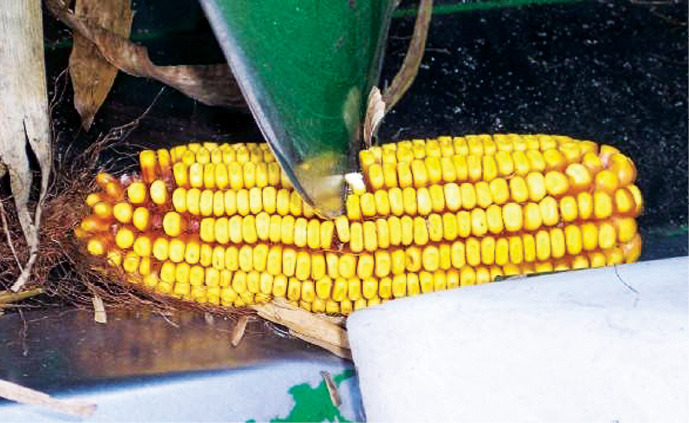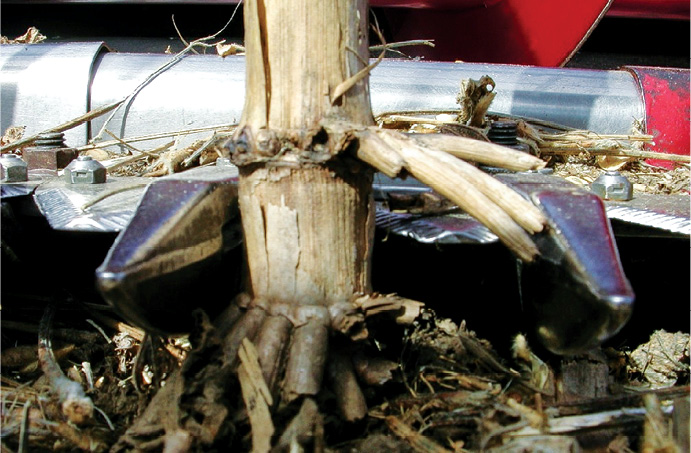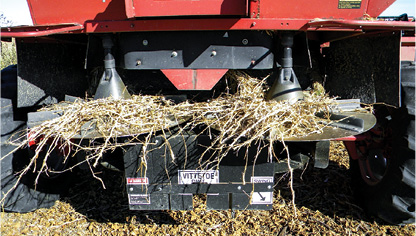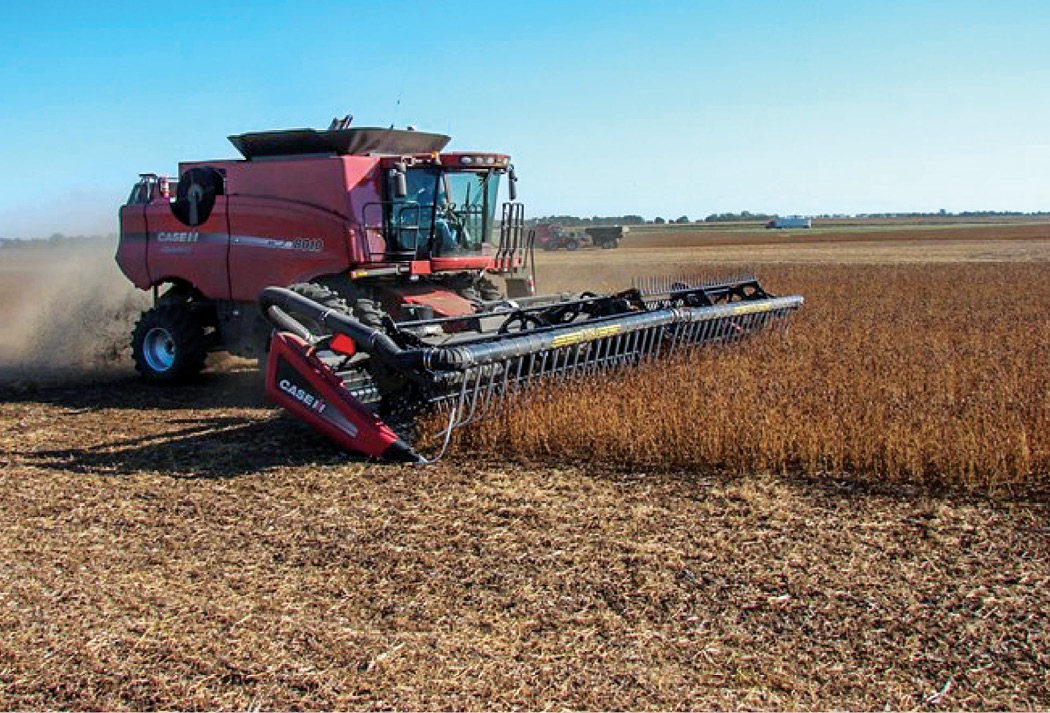Pictured Above: UP OR DOWN? Soybean populations can have a direct effect on pod heights. No-tillers preferring to cut soybeans close to the ground will need to adjust sickle bars to the correct height, says Alpha, Ill., no-tiller Marion Calmer.
Even with the progression of combine technology today, no-tillers can still lose a considerable amount of grain during harvest if their combine settings aren’t correct.
At the 2015 National No-Tillage Conference in Cincinnati, Calmer Corn Heads owner and Alpha, Ill., no-tiller Marion Calmer offered the following tips for adjusting your combine’s settings to leave less grain in the field, which should improve the machine’s efficiency and create more favorable seedbed conditions for the next planting season.
Harvesting Soybeans, Wheat and Oats
1 Adjust the Sickle. Most no-tillers like to cut soybeans as close to the ground as possible and that requires operators to adjust the sickle height correctly.
Calmer says no-tillers should take soybean populations into consideration because this affects the height of the pods. Research trials on his farm show a population of 150,000 had pod heights of 6 inches, while a population at 75,000 had pod heights of 4 inches.
“So when you plant thinner stands, soybeans pods are closer to the ground, therefore the sickle must be adjusted close to the ground to cut below the pods,” he says.
On Case IH feeder houses, the faceplate is adjustable and growers can loosen the side bolts and adjust a top-threaded turnbuckle to raise and lower the sickle. Lengthening the turnbuckle will rock the sickle closer to the ground.
Feeder houses on Deere machines also have adjustable faceplates. MacDon draper headers already have adjustable hydraulic cylinders to let operators change the sickle height on the go, he notes.
The distance between sickle snakeheads can be another no-till issue, Calmer notes. Brace roots from old corn residue can measure up to 3½ inches wide, but when the distance between snakeheads is less than 3 inches, they may plug, he says.
“It’s tough to shove a 3-inch object into a 1½-inch hole,” he says. “I once ran two combines in the field with different sickle snakehead sizes and did a much better job with a 3-inch sickle.
“We’re seeing more and more residue every year, and any time you get a slight obstruction there’s the potential to push a soybean plant forward before cutting it off.”

CUT UP. If the flighting is set incorrectly during harvest, that can lead to the equipment slicing through husks, kernels and the cob, resulting in cracked kernels in the tank, says Marion Calmer. Raise the cross auger so the clearance between the flighting and the tray is 1¾ inches high, he advises.
This creates a ragged cut and greater header loss, he explains.
Calmer says some newer grain platform models have full-fingered cross augers with retractable fingers throughout the entire length of the header that might improve residue and crop flow. Many growers don’t realize there are two types of material coming across the sickle.
“We want material to flow easily from the sickle into the cross auger — especially at night with damp soybeans because stalks underneath are damp too.”
2 Setting the Cross Auger. No-tillers running an auger-fed platform should run them with a ¹/₈-inch clearance between the flighting and the tray, Calmer says.
This closes the gap, makes the auger more aggressive and helps pull soybeans away from the sickle.
“Draper platforms resolve a lot of issues that have plagued auger-fed platforms for years,” he notes.
3 Fixing Threshing Issues. Additionally, green pods in the grain tank have been a major problem for no-tillers for many years. Green pods are a threshing problem, not a separation problem, says Calmer.
“The old timers did that in the 1940s and 50s and we’re no different here in the 21st century,” he says. “The best way to thresh grain is to rub grain against itself. Concave filler plates allow us to accomplish this.”
For Case IH combines, installing concave filler plates significantly improves results.
“You’d be surprised how much easier it is to set the machine with those concave filler plates installed,” Calmer says. “You won’t have anywhere near the amount of cracked beans in the tank, and you won’t have to bear down on that bottom sieve.”
Round bar concaves found on Deere combines are fine for corn, Calmer notes, but aren’t tight enough for proper threshing in soybeans, wheat and oats.
Deere created a snap-in concave insert — part number AH204423 — for harvesting these crops that only takes 4-5 minutes to insert.

PULL A PLANT. Problems with residue flow can occur during soybean harvest if brace roots from old corn residue can’t fit in the gap between snakeheads on the sickle bar. Based on field tests on his farm, Marion Calmer says he’s had better luck with a 3-inch sickle compared to a 1½-inch sickle.
“This allows the soybeans to stay in the threshing chamber so they can gently rub against each other to successfully open the pods. That’s the best way to thresh grain,” he says. “The last thing you want to do is put steel against grain because it will cause it to crack.
4 Adjusting Sieve Settings. Calmer says he’s been running a combine for more than 40 years and 2014 was the first year he was able to harvest soybeans with the bottom sieve on his Case IH combine wide open.
“Every year at harvest it seems soybean stems are greener and greener, but the pods are dry,” he says.
If no-tillers can improve threshing, they may have no need for a bottom sieve and can keep it open to let air flow through.
It’s human nature to start closing down the bottom sieve to clean the tank, but in reality that decreases airflow.
“It’s like blowing air into a pop bottle — it won’t work,” Calmer says. “Once you start to close sieves, all the air flows horizontally toward the back end of the machine until it finds an escape route.
“If you do a kill stop with the machine and look in the tailings elevator, there should not be any soybeans in it.”
He adds that if you do a kill stop, you can see the hulls are located on the top sieve of the cleaning area.
“We want to keep them up here,” Calmer says. “We don’t want to let them fall through and get into the clean grain.
“So, how do I clean the grain tank? I open and close the top sieve to keep the hulls out of the grain tank, and then we just open up the back end of the sieve to allow the un-threshed pods to drop into the tailings auger and go back for a second pass.”
Harvesting No-Till Corn
5 Stripper Plate Settings. Calmer says stripper plate settings are determined by the size of the stalk, which will be relative to corn population.
“You can talk about butt shelling or trash intake all you want. But at the end of the day, the stripper gap is determined by the girth of node on the corn stalk,” he says.
During harvest, no-tillers should get out of the cab, yank a stalk out of the ground and measure the node on the lower part of the corn stalk, and then walk over to the stripper plates and try to push the stalk in.
In one example, he measured a stalk node at 1³/₈ inches wide, but the stripper gap was set to 1¼ inches. You can’t successfully shove a 1³/₈-inch node into a 1¼-inch gap, he says.
“If the stripper plate engages with the node it’s going to lean the corn stalk forward and you won’t get good stalk chop. The gathering chain will grab it and shear it off.”
Don’t Windrow Straw and Chaff

Marion Calmer says he’s seeing a trend in combine design toward closing up the rear end of the machine to force the straw and chaff to be spread from the same area.
But tightening up the back end of the machine creates the same “blowing air into a pop bottle” effect and it wears out the fan belts and significantly reduces performance.
To improve spreading soybean chaff, he purchased a Vittetoe chaff spreader.
Another thing to remember: Start harvesting soybeans on the downwind side of the field. This allows the wind to be used as an asset instead of a liability to spread residue, he says.
"You don’t want the chaff and straw being spread into the uncut soybeans,” Calmer says. “You want to go out and drive by in a pickup truck and not be able to tell where the combine was in the field.”
Calmer suggests the stripper plate gap be ¹/₁₆ inch wider than the widest portion of the lower corn stalk nodes.
6 Opening the Window. Calmer notes that many corn headers have intermeshing straight fluted stalk/knife rolls with too much overlap in the entry area.
When rotating at normal speeds, these intermeshing flutes have no entry window, preventing the stalk from engaging easily with the flutes and causing early wear of the spiral and first 2 inches of flutes.
This hesitation, he says, results in stalks and ears passing below the corn head without being processed.
“From a corn stalk’s perspective, when the stalk rolls are spinning 1,000 rpm, you’re essentially looking at a solid wall of rotating steel,” he says. “The rotating steel slows entry of the corn stalk, therefore leans it forward and ultimately won’t engage the stalk.”
Calmer’s solution was to design the “BT Chopper” stalk rolls with shortened flutes timed to create two 4-inch open window-feeding chambers. This lets stalks move into 10 razor sharp knives that chop, cut and shear corn stalks into confetti-like residue, he says.
“You need to have stalks engaged so they go downward and rearward,” he says. “This feeds the stalks better and the corn head works better.”

“If the stripper plate engages with the node, it’s going to lean the corn stalk forward and you won’t get good stalk chop. The gathering chain will grab it and shear it off…” — Marion Calmer
7 Calibrating Header Speed. Calmer says it’s typical to calibrate soybean platforms so the reel runs at 10 times the ground speed when harvesting soybeans or wheat.
But how often do no-tillers calibrate corn head speed before they start?
“I did the math on the length of the gathering chains, and the rule of thumb is that 55 rpms on the gathering chain is equal to 4 mph in ground speed,” he says. “We want the gathering chain lug and the stalk to come into the corn head simultaneously.”
So before corn harvest begins, calibrate your header speed by painting one lug of the gathering chain to make it more visible, he says.
From the operator seat, start the combine, let it run on full speed while stopped and count the revolutions per minute. Adjust accordingly.
Calmer suggests the gathering chain be sped up for faster ground speeds, or decreased for downed corn or to reduce butt shelling.
8 Avoiding Ear Slicing. Some no-tillers may observe the steel flighting slicing through the husks, kernels and the cob, resulting in cracked kernels in the tank.
Calmer says raising the cross auger should be enough to prevent this.
“Ears should push ears down the tray. Set the clearance between the flighting and the tray at 1¾ inches high,” he says.
9 Stopping Ear Toss. At times no-tillers might see ears of corn flying out of the feeder-house area and onto the ground in front of the combine.
During the handoff of material between the cross auger and feeder chain, ears hesitate and will pile up high enough that the auger will start to backfeed and suck the ears over the top and toss them onto the ground.
“There’s a 16-inch dead air space between the two conveying systems. The auger is then required to push everything up an 18-degree slope while simultaneously pushing the harvesting material through the dead air space,” Calmer says.
“To minimize the amount of ears that pile up during this handoff between the two conveyors, bring the cross auger and feeder-house chain as close as possible to each other. One way to do this is to lengthen the feeder chain. I had to put in five rollers to lengthen my feeder chain to get it down close to the cross auger.”
Leaves Stalks Standing, or Chop Them?
Alpha, Ill., Marion Calmer admits there is sometimes an intense debate among no-tillers on what to do with corn stalks during harvest — leave them standing, or chop them?
Some no-tillers like to leave stalks standing to protect ag tires and give soils a chance to dry out and warm up in spring. Last year, Calmer cited on-farm research he did with soil scientist Jill Clapperton that found residue processed and put on the ground decomposed faster.
Calmer also notes the size of material left on the soil surface after harvest can have an impact on seeding depth and down-pressure requirements for planters in spring.
“At least if the residue is on the ground the earthworms can get to it,” says the owner of Calmer Corn Heads. “The epidermis of the outer shell on corn stalks is hard and worms struggle to eat through that, and it’s hard to get any bacteria or fungus there to start breaking it down.”
Calmer recommends using the large feeder house chain drive sprocket for harvesting corn with Deere combines, not the small one. This increases feeder chain speed, which will help to pull the material away from the cross auger.
10 Sieve Settings for Corn. In corn, the bottom sieve is not needed. There is no part of the cob or kernel that needs to be re-threshed, he says.
Therefore, the bottom sieve should be wide open so kernels fall directly into the clean auger, Calmer says. This allows the bottom sieve to function as a wind board to direct the air blast to the front of the top sieve, where it’s needed for cleaning.
During corn harvest there should be nothing in the return elevator but the chain and paddle, he notes.
“I suggest a couple of kill stops to confirm this. The top sieve is now the cleaning sieve and has plenty of capacity to perform this function without losing kernels out the back,” Calmer says.
“I open and close the top sieve as kernel size and moisture change to remove 95-99% of the cobs from the grain tank. Sieve loss should be less than separator loss.”








Post a comment
Report Abusive Comment